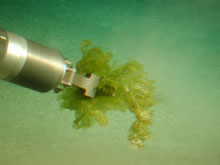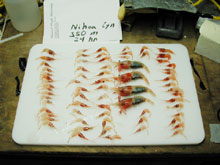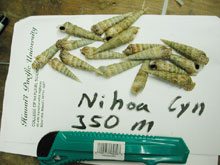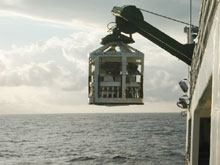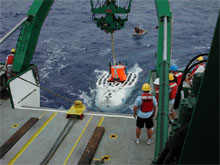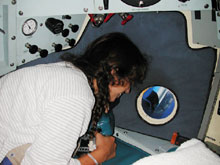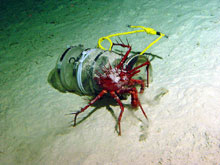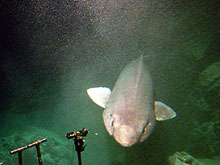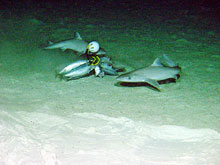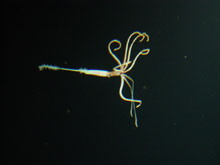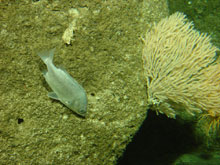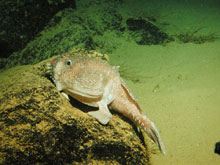
A goosefish (Sladenia remiger) sits on a rock in a submarine canyon, using its modified dorsal fin to lure unsuspecting fishes to its mouth. Click image for larger view and image credit.
Leg I - Submarine Canyon and Scavenger Communities in the Main and Northwestern Hawaiian Islands
September 3 - 26, 2003
Dr. Craig R. Smith
University of Hawaii at Manoa
Dr. Eric Vetter
Hawaii Pacific University
Dr. Frederic H. Martini
University of Hawaii at Hilo
Submarine canyons are common features along the ocean's slopes, but they are poorly explored. Canyons are potentially important deep-sea habitats because they trap detrital materials that move across the shelf and slope, providing food to a variety of organisms. For example, suspension feeders benefit from the faster currents found in the canyons, demersal planktivores exploit dense layers of krill and other vertical migrators that concentrate in the canyons, and detritivores benefit from the large amounts of sediment and macrophytes that accumulate in the canyons. In addition, canyons serve as food-rich patches, critical to the recruitment success of many commercially important demersal fishes.
Canyons are likely to be hotspots of biodiversity because they support a variety of habitats due to the presence of rocky substrates, detrital mats, organically enriched sediments, intense currents, and the seepage of reduced pore waters. The biological communities and ecological role of the canyons on the Hawaiian Slope are wholly unexplored, even though these food-rich habitats may be disproportionately important as recruitment sites in the oligotrophic ocean. We proposed to explore the role of submarine canyons on the slopes of the main and Northwestern Hawaiian Islands in benthic production, as juvenile fish habitat, and in the maintenance of biodiversity.
The first leg of this project, a study of the canyon and slope habitats in the Northwestern Hawaiian Islands, took place aboard the Research Vessel Ka'imikai-o-Kanaloa. The cruise was overwhelmingly successful in terms of meeting our goals regarding submarine exploration, hypothesis testing, data collection, and the number of dives completed. All 12 dives on the Pisces IV manned submersible went according to plan, and we made an additional eight dives using the remotely operated vehicle (ROV) RC-150.
We conducted quantitative megafaunal surveys using video from the ROV and direct observations with the Pisces IV. In addition, we collected tube cores for infaunal and grain size analyses, made quantitative observations of scavenger aggregations at standard baits, and caught scavengers using baited traps. Later, these data will be used to examine the differences between submarine and scavenger communities by depth and habitat type (whether inside or outside submarine canyons). Using these data, we will determine species abundance, community structure, and the diversity of megafaunal assemblages; the abundance, diversity, and biomass of infauna; and the species assemblages, population genetics, and trophic structure of scavenger communities.
Preliminary analyses indicate that the abundance of both fish and invertebrate megafauna increased from the open slopes into the canyons, and as depth increased. As predicted, the megafauna were more diverse in regions with more rugged topography, a common feature of canyons. Unexpectedly, we found apparent enhancement of benthic populations by concentration of macrophyte detritus in the canyon located off Nihoa Island. The concentration of green algae detritus that we observed at a small, low island in a canyon with a deep head (330 m), and located far off shore, was remarkable. The increase in megafaunal abundance with depth was surprising because the flux of organic matter, and the biomass of sea- floor communities, normally declines exponentially with depth downslope.
We hypothesized that the relatively low biomass at 350 m (compared to deeper depths) resulted from high predation pressure from shallow-water predators (e.g., the amberjack, Seriola dumerili) that occasionally wander into deep water. On many occasions, we observed amberjacks feeding on sluggish deep-water fishes at depths to about 400 m, even though amberjacks are generally considered epipelagic predators. In addition, fish biomass at the deeper stations (650-1,000 m) may have been enhanced by the presence of prey in the form of vertical migrators (small nekton crustaceans and fishes) that feed in surface waters at night, and migrate below the depth of light penetration (~600 m) during the daytime.
The scavenger communities were surprisingly diverse and extremely active, suggesting a remarkably large carrion flux on the slope around the Northwestern Hawaiian Islands. Within the first half hour, bait parcels at our 650 and 950 m stations attracted a number of large rays and sharks, including at least three species not previously observed by submersibles in Hawaiian waters (an eel, Simenchelys parasitica; a 3-m-long, six-gill shark, Hexanchus griseus; and a 3-m-long false cat shark, Psuedotriachis acrages). Other major scavengers included lysianassid amphipods, several species of large shrimp (Heterocarpus sp.), and the voracious ray (Plesiobatis daviesi). Scavengers were larger, more abundant and more diverse inside canyons than outside. Scavengers were also more abundant at deeper stations (650-950 m), which is consistent with the expected higher concentration of biomass at this depth.
We conducted similar studies off Oahu from November 18 - December 1, 2003. This cruise, funded by NOAA's Office of Ocean Exploration and the Hawaii Undersea Research Laboratory, resulted in equally dramatic discoveries. We observed far greater diversity and abundance of mobile megafauna in submarine canyons that were associated with embayments. Relative to sites outside of canyons, increased diversity and/or abundance of animals in canyons was observed for fishes at depths of 600 to 1,000 m, shrimp (Heterocarpus ensifer) at 300 to 500 m, and scavenging species, generally, at all depths (300 to 1,500 m). The food webs in the canyons appeared to be subsidized by large quantities of algal detritus, which was observed at all depths.
To allow further comparisons between canyons in the Northwestern and Main Hawaiian Islands, the Hawaii Undersea Research Laboratory has awarded us 12 dives to explore the deep canyons on the north side of the island of Molokai in 2004.
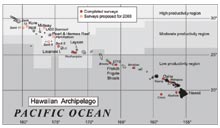
Map of the proposed 2003 survey expedition of the Hawaiian Archipelago. Click image for larger view and image credit.
Regional Productivity of the Northwestern Hawaiian Islands
Frank Parrish
Pacific Island Fisheries Science Center
NOAA, National Marine Fisheries Service
Greg Marshall
National Geographic Television and Film
Our submersible dives at the north end of the Hawaiian Archipelago revealed some exciting discoveries. The focus of the work was a comparison of subphotic fish communities of the southern archipelago to the fish communities of the northern archipelago, where oceanic productivity is the highest. This was of particular interest because the endangered Hawaiian monk seals in the south exhibit poor survivorship compared to those in the north, and there has been much speculation about differing prey availability between the two regions. During our exploration, a number of organisms were encountered that had never before been seen in their underwater landscape. Some of these are potentially new species, such as this ![]() eight -armed squid we found drifting midwater.
eight -armed squid we found drifting midwater.
Other species that we observed are poorly described because they are not easily captured with conventional fishing gear (e.g., hooks and nets). Most exciting, however, was the overall difference in the fish community, corresponding to the higher productivity of the subtropical front. Our first dive was south of the front at Bank 8, and the fish community appeared similar to southern sites we had surveyed in earlier years. We then traveled 120 mi north to Pearl and Hermes, where the mean size of certain fish taxa were noticeably larger. When we moved further north, to the seamounts of Ladd and Nero, we began to see different types of fish, including armorhead, which is a known prey species for monk seals. There was an even greater abundance of armorhead at Seamounts 10 and 11, the northernmost stations. The highlight of the expedition was when ![]() two monk seals, swimming near the submarine at 500 m, were caught on videotape, probably the greatest depth at which this species has ever been observed.
two monk seals, swimming near the submarine at 500 m, were caught on videotape, probably the greatest depth at which this species has ever been observed.
This expedition provided the first visual surveys of subphotic depths at the north end of the Hawaiian Archipelago. Data on species richness, size, structure, and abundance were collected and will be compared to data collected at southern stations. These analyses will provide insight to the plight of the endangered Hawaiian monk seal, and, it is hoped, will spur interest in future surveys of Hawaiian seamounts.










